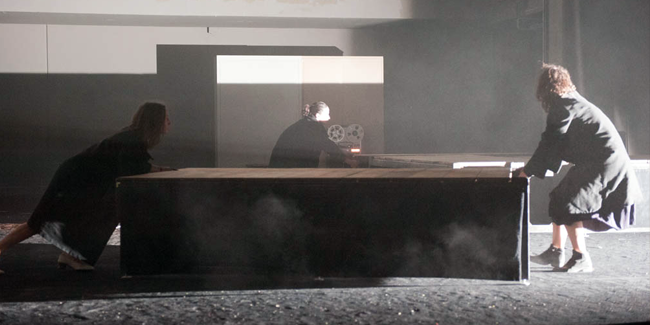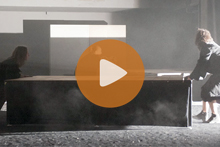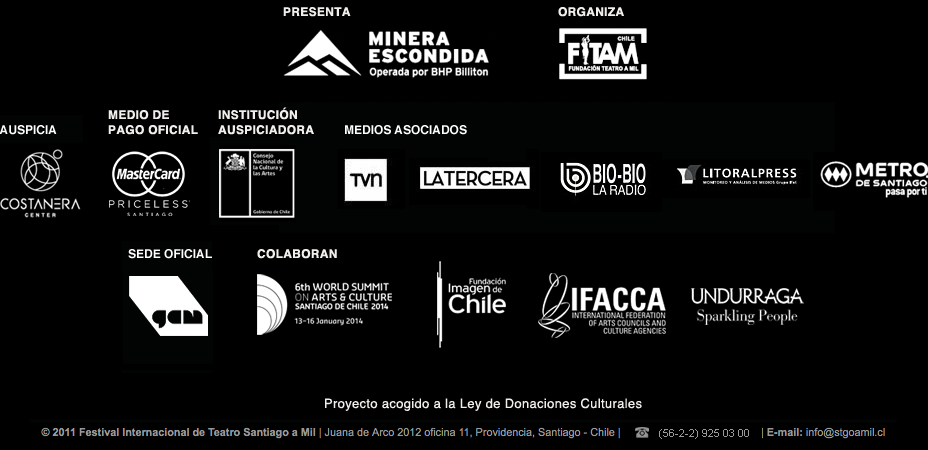SALVESSALVOS

Foto: Didier Grappe
FRANCIA
Concepción Maguy Marin
Compañía Cie Maguy Marin
Este enero, Marin vuelve para dejar una huella profunda en la historia de la danza en Chile. Este espectáculo de danza-teatro sube la fuerza de la resistencia al escenario, “para que podamos escapar de todo lo que nos deprime y absorbe nuestra energía”, en palabras de su creadora.
«Al final de Salves, frente a los siete bailarines que lo han dado todo, la primera reacción es callarse. Callarse largamente o dar gracias entre susurros». Télérama.
RESEÑAUna escena en remodelación, en negro. Una antorcha se enciende, como una luz de esperanza en un paisaje caótico, un hilo tendido en un mundo a la deriva. Maguy Marin, la gran coreógrafa francesa, hace surgir en Salves fuerzas diagonales que se entrechocan y cruzan en el lío sonoro compuesto por Denis Mariotte. Artista generosa e intranquila, Marin sondea el imaginario colectivo con referentes populares que hace volar en pedazos y estrellarse para, finalmente, reconstruirlos.
Mientras los siete bailarines intentan combatir el ambiente fatalista y salvar lo que aún puede serles útil de este mundo “con la mierda hasta el cuello”, los gestos coreográficos de Maguy Marin acompañan este naufragio entre pesadilla y onirismo, entre lucha y poesía. Ante la frase de Walter Benjamin “hay que organizar el pesimismo”, la coreógrafa responde haciendo vibrar el escenario “con momentos inestimables que sobreviven al olvido”.
Marin lleva más de 30 años asumiendo el riesgo de mezclar danza y teatro, con absoluto éxito. Desde el Centre Chorégraphique National de Rillieux-le-Pape, ha creado esta última pieza que ha sido mundialmente aclamada como una obra maestra. En palabras de la creadora, es un manifiesto político, “un alto al fuego donde las imágenes se hacen pedazos y la furia supera la desesperanza, una buena descarga de relámpagos en medio de la noche”.
Maguy Marin es una de las personalidades más relevantes de la danza contemporánea francesa. A fines de los 70 fundó su propia compañía, hoy todo un ícono en la escena independiente de su país. Bajo la tutela de Maurice Béjart aprendió técnicas del teatro, el yoga, el arte del mimo. Su estilo suele ser definido como danza-teatro, por su fusión de la voz, la actuación y el ritmo. Entre 1998 y 2011 dirigió el Centre Chorégraphique National de Rillieux-la-Pape, para luego emprender un camino independiente junto a su compañía, asentándose en Toulouse.
Sus más de 50 creaciones le han valido elogiosas críticas en todos los numerosos países que ha visitado, ofreciendo siempre talleres y ensayos abiertos al público. Así fue su visita a Chile en 2003, cuando presentó en el Teatro Municipal de Viña del Mar, Los aplausos no se comen, inspirada en una cita del autor uruguayo Eduardo Galeano en Las venas abiertas de América Latina. El arte de la escena es para Maguy Marin “ese lugar donde se intenta que la gente no se olvide de ella misma”, y un “laboratorio ciudadano destinado a las miradas de la ciudad”.
«Maguy Marin descarga la furiosa locura de un mundo enfermo. No por nada tituló como Salves su nuevo espectáculo. Con repetidos disparos y estruendosas explosiones, el escenario parece el escombro del siglo XXI, con sus hordas de humanos apenas reconocibles y sus íconos destrozados en mil pedazos. Libertad, la República, “bella danza”, conducen al Guernica de Picasso. Los misiles de Maguy Marin alcanzan a la audiencia, que acogió esta obra maestra de la coreógrafa con un larguísimo aplauso. La estructura de la performance, sólida y repetitiva, como suele hacer la coreógrafa, alcanza un nivel poco común. El sistema de apariciones como destellos, coincidiendo con cada vibración, con el impacto de la irrupción de una pesadilla. Las pequeñas escenas móviles, los impredecibles ataques de bailarines desde cada rincón del escenario, sostienen la ansiedad…
Bastante cinematográfica en su energía nerviosa y su montaje, Salves puede también ser leída como la puesta en escena de un espíritu poseído por imágenes traumáticas… Como un manifiesto, Salves magníficamente reúne todo el talento de Maguy Marin. Combina una noción extremadamente práctica del escenario (espacio, arquitectura, iluminación), la ciencia del ritmo visual y musical, y el sentido de teatralidad, todo blindado con una inteligencia férrea.
Maguy Marin sabe lo que quiere y encuentra la forma de enviar el mensaje, sin desviarse hacia lo simplista o demagógico. Política en su sentido más firme, esta pieza toca la alarma de un mundo enfermo, donde la rabia supera cada día a la desesperación». Rosita Boisseau. Le Monde. 16 de septiembre de 2010.
Concepción Maguy Marin
En colaboración con Denis Mariotte
Interpretes Ulises Álvarez, Romain Bertet, Kaïs Bertet, Laura Frigato, Daphné Koutsafti, Mayalen Otondo y Jeanne Vallauri
Dirección técnica e iluminación Alexandre Bénetaud
Concepción y realización de la escenografía Michel Rousseau
Accesorios Louise Gros y Pierre Treille
Realización de vestuario Nelly Geyres
Sonido Antoine Garry
Coproducción Biennale de la danse de Lyon 2010, Théâtre de la ville de Paris, Centre chorégraphique national de Rillieux-la-Pape/ Cie Maguy Marin
Estreno Biennale de la Danse de Lyon, septiembre de 2010
Duración 1 hora 10 minutos

Photo: Didier Grappe
FRANCE
Conceived by Maguy Marin
Company Cie Maguy Marin
This January, Marin returns to leave deep tracks in the history of dance in Chile. This dance-theatre production brings the power of resistance to the stage, “to enable us to escape from everything that depresses us and absorbs our energy,” in the words of its creator.
«At the end of Salves, the seven dancers who have given their all face an audience stunned into silence. They remain silent or express their thanks between whispers.» Télérama
SYNOPSISA scene being remodeled, dressed in black. A torch is lit, like a glimmer of hope in a chaotic landscape, a thread suspended in a world adrift. In Salves, the great French choreographer Maguy Marin creates a work in which diagonal forces intersect and come into contact, backed by a complex soundtrack composed by Denis Mariotte. A generous, restless artist, Marin probes the collective imagination with popular references that explode and ultimately reconstruct it.
While seven dancers attempt to fight off an environment of fatalism and salvage what they can from this world “up to our necks in shit,” the dance moves of Maguy Marin accompany this shipwreck set between dream and nightmare, between poetry and struggle. Walter Benjamin’s statement that “we have to organize pessimism” drives the choreography, which resonates on stage “with priceless moments that will not be forgotten.
For more than 30 years Marin has been undertaking that risky fusion of dance and theatre with absolute success. From the Centre Chorégraphique National de Rillieux-le-Pape she has created her latest piece, which has been acclaimed worldwide as a masterwork. In the creator’s own words, it is a political manifesto, “a ceasefire in which the images fall to pieces and fury overcomes despair, a lightning storm in the middle of the night.”
In the beginning, a birthplace, Toulouse. A haven reached after many wanderings that followed political turmoil in Spain. And there, in France, growing up in the early fifties. Then comes the irresistible aspiration to dance, materialized by a sequence of studies – from Toulouse to Strasbourg, later with Mudra (Brussels) under Maurice Béjart, Alfons Goris and Fernand Schirren… – already marked by a taste for encounters, notably with the student actors of the Théâtre National de Strasbourg. That trait of hers blossoms within the Chandra group, then with the Ballet du XXè siècle. Her own creative work begins alongside Daniel Ambash and the Nyon and Bagnolet competitions help that impulse to gain momentum.
Between 1980 and 1990, with the trustful support of the team of la Maison des arts de Créteil steered by Jean Morloch (from 1981 to 1990) and the constant help of public funding, her research follows its course with Christiane Glik, Luna Bloomfield, Mychel Lecoq and Montserrat Casanova’s complicity. In 1985, her group becomes the Centre chorégraphique national de Créteil et du Val de Marne: its artistic work is intense, its achievements spread worldwide. The newborn company is reinforced by Cathy Polo, Françoise Leick, Ulises Alvarez, Teresa Cunha and many others. Searching and searching again, with the company as foundation. A relentless attempt at group work and at making a living out of it, through sheer willpower and thanks to a wealth of co-workers.
1987. A new encounter – with Denis Mariotte – is the starting point of a decisive partnership which opens the gates of experimentation. Viewpoints begin to shift and extend into manifold directions.
1998. A new site to settle in. It is a new territory for a new Centre chorégraphique national at Rillieux-la-Pape, located in the district of la Velette, with the urgent need to conquer afresh the public space for a lavish celebration of our differences and for the ever so pleasurable and lively game of creation. Thanks to multifarious supports, which allow the progress of what cannot be achieved singly, the endeavours are hosted in a variety of areas (Intercommunalité [Intermunicipal Authority]: Rillieux-la-Pape, Bron, and Décines up to 2006, Villefranche-sur-Saône, until 2000, Villeurbanne until 2003) and are backed by complementary public aids (State, Rhône-Alpes Region and Rhône General Council).
Year 2005: a new building for the CCN at Rillieux-la-Pape. The new place must now be dwelled and co-dwelled in: a place meant to be a criss-cross of presences purposefully moving in a common space within the CCN in Rillieux-la-Pape; a place as a “we, in time and space” which strengthens our ability to foster “those diagonal forces resisting oblivion” (H. Arendt). Whether in the Studio or the district of la Velette, in cities, partner- or foreign, and beyond, everything is about sharing means, tools, experiences and actions. About meshing artistic domains, about creating and supporting new research, about mooring art centres in various locations dedicated to social life, be it intimate or more widely open – from schools to theatre houses, art centres to social centres, public spaces to open homes, from research establishments to district centres. In every place, the artistic venture is at work, enacting the poetic power to shape and reshape our worlds; at work to reveal the poetics of being-with-the-world which leads us to strive for a unison (possibly dissensual) with our surroundings; to delineate the space for a public poetic manifesto to emerge; to offer a people’s laboratory meant for the gaze of the polis. What is at stake is the creating and expressing, through public address, of those slivers of our existence which art mirrors for us.
2011 witnesses another form of deployment into a research unit with neither place nor position. The endeavour is no longer that of a CCN but that of the continuing quest for the tension between diverse views and queries all brought together – unfailingly supported by faithful co-workers, by a team, by a company.
PRESSMaguy Marin unloads the furious madness of a sick world. Maguy Marin didn’t title her new work Salves – Salvos – for nothing. Repeated shots,
loud explosions, the stage resembles the shattering of the 21st century, with its hordes of barely recognizable humans and its icons, into a thousand pieces. Liberty, the Republic, “beautiful dance”… give way to Pablo Picasso’s Guernica. Maguy Marin’s missiles have reache the audience, who welcomed this masterpiece by the choreographer with long – very long – applause… The structure of the performance, solid but repetitive, as often with the choreographer, here takes on a rare scale. The system of flashed apparitions, exacting to the nearest quaver, with the impact of the irruption of a nightmare. The small mobile scenes, the unpredictable attacks by dancers from every corner of the stage, sustain the
anxiety…
Quite cinematographic in its nervous energy and its montage, Salves can also be read as the staging of a spirit haunted by traumatic images… a manifest work, Salves magnificently gathers together the talent of Maguy Marin. It unites an extreme practical knowledge of the stage (space, architecture, lighting…), the science of visual and musical rhythm and the sense of theatricality, all armoured with steely intelligence.
Maguy Marin knows what she wants and finds the means to send the message, without detouring into the simplistic or demagogic. Political in the
strongest terms, this piece sounds the alarm to a sick world, where rage still wins the day over despair. Rosita Boisseau. Le Monde. 16 September 2010.
Choreography and design Maguy Marin
In association with Denis Mariotte
Performers Ulises Álvarez, Romain Bertet, Kaïs Bertet, Laura Frigato, Daphné Koutsafti, Mayalen Otondo and Jeanne Vallauri
Technical direction and lighting design Alexandre Bénetaud
Set design Michel Rousseau
Accessory design Louise Gros and Pierre Treille
Costume design Nelly Geyres
Sound design Antoine Garry
Coproduction Biennale de la danse de Lyon 2010, Théâtre de la ville de Paris, Centre chorégraphique national de Rillieux-la-Pape/ Cie Maguy Marin
Premiere Biennale de la Danse de Lyon, september 2010
Length 1 hour 10 minutes

